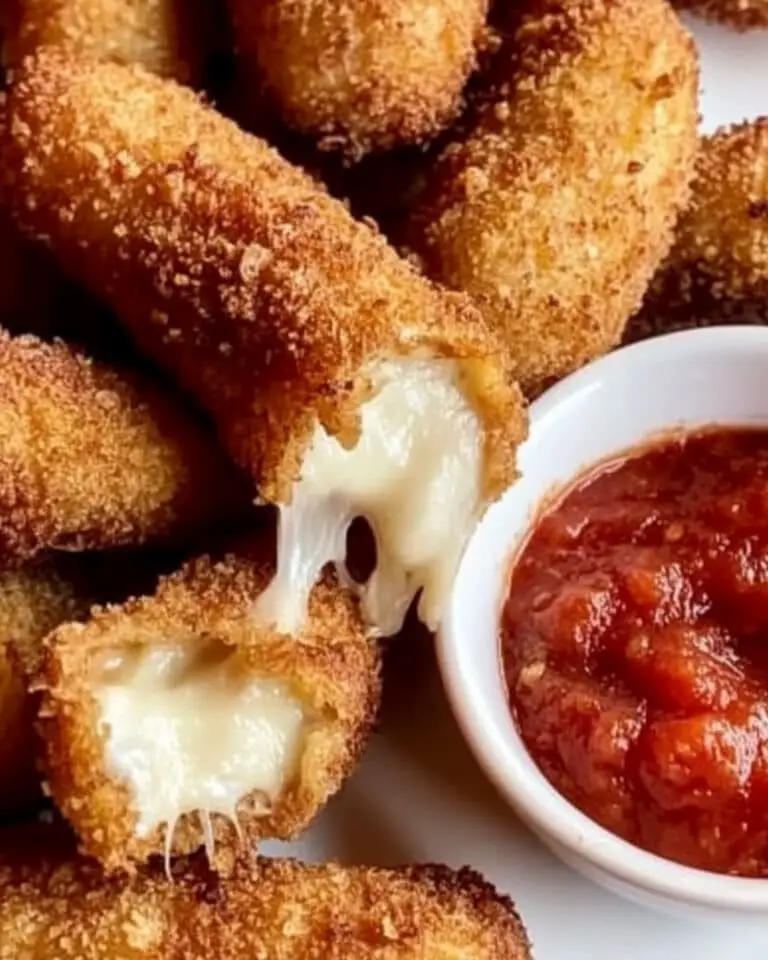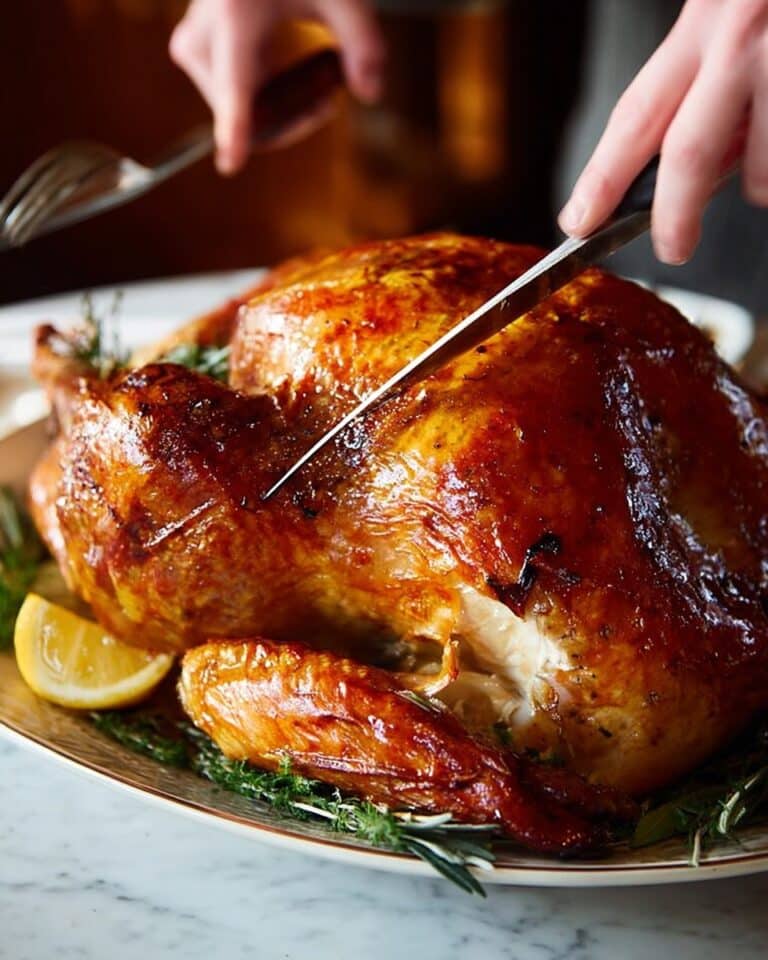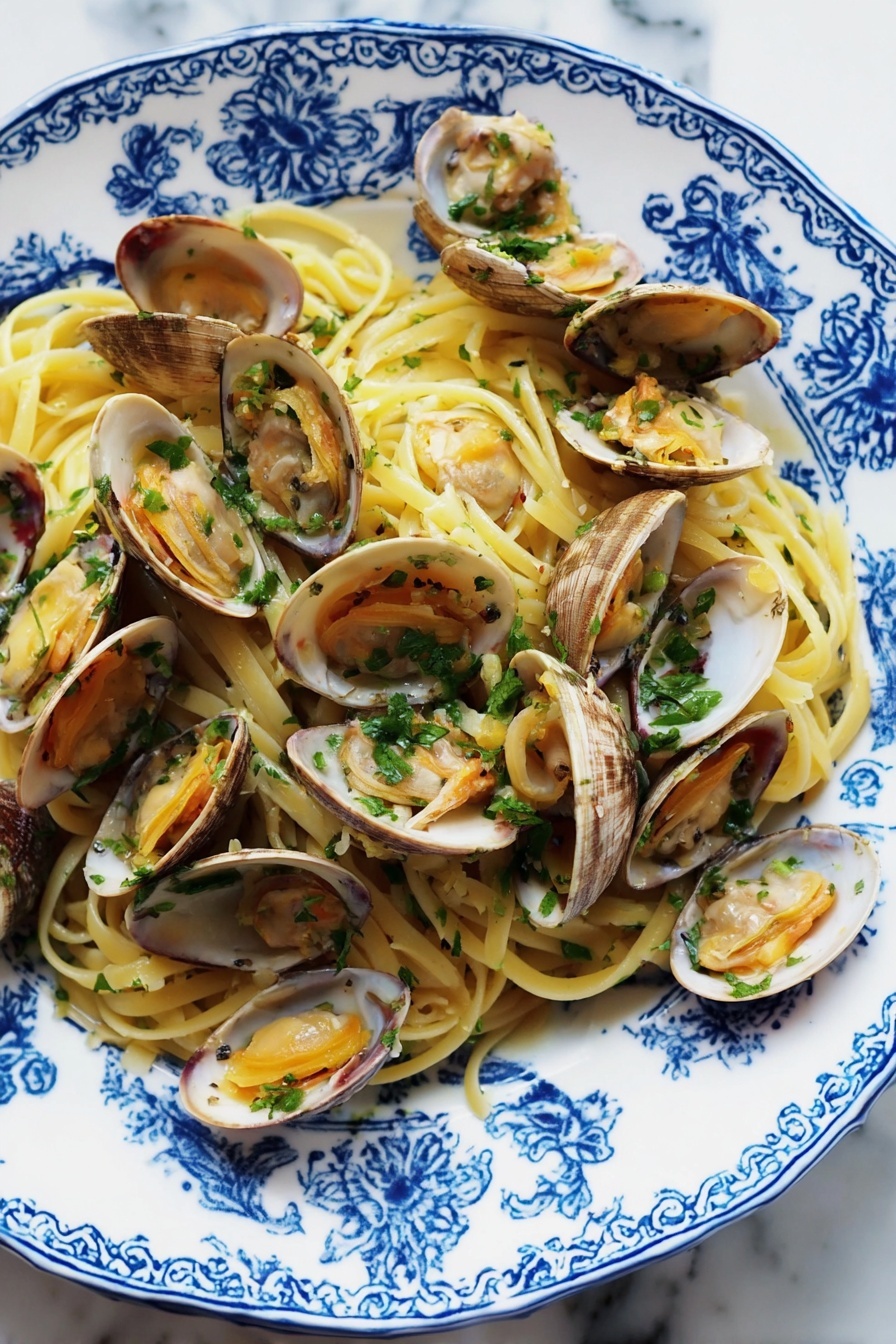
If you’re craving a taste of the sea that’s both elegant and surprisingly simple, you’re going to love this Linguine with Clams Recipe. I absolutely love how effortlessly this dish comes together, yet it feels like something you’d order at a seaside trattoria in Naples. Whether you’re cooking for family or impressing guests, this recipe delivers fresh, briny clams tossed with perfectly cooked linguine, garlic, and a hint of chili heat. Trust me, once you try it, this will become a go-to whenever you’re looking to bring a bit of Italian magic into your kitchen!
Why You’ll Love This Recipe
- Fresh Flavors: The clams provide a natural saltiness that perfectly complements the garlic and parsley, making each bite vibrant and satisfying.
- Quick and Easy: Ready in under an hour with minimal prep, it’s a fantastic choice for a special dinner that doesn’t keep you in the kitchen all night.
- Impresses Every Time: I’ve served this to friends who’ve never cooked seafood before — it instantly elevates any meal.
- Versatile and Adaptable: You can adjust the chili, swap linguine for spaghetti, or go heavy on parsley to suit your taste.
Ingredients You’ll Need
Each ingredient has its part to play in this Linguine with Clams Recipe. Choosing fresh clams and good-quality olive oil truly makes a difference. I love using fresh parsley—it brightens up the whole dish beautifully. Here’s what you’ll want to gather before you get started.

- Linguine: This pasta shape holds the sauce perfectly, but spaghetti or vermicelli work just as well if you prefer.
- Fresh Clams: Go for littlenecks or small clams with tight shells; freshness is key to avoid sandy bites.
- Garlic: Lots of it! Finely chopped, so it gently infuses the oil without getting bitter.
- Peperoncino (Red Chili Flakes): Add to your heat preference—start with a little and add more if you like it spicy.
- Extra Virgin Olive Oil: Use good quality; it’s the base of your sauce and adds a fruity richness.
- Fresh Parsley: Chopped finely for freshness and color; it really wakes up this dish.
- Salt: Used sparingly since clams are naturally salty; I usually skip salting the pasta water.
- Dry White Wine (Optional): Adds depth; if you don’t cook with wine, you can omit, but it does elevate the flavor.
Variations
I love how this Linguine with Clams Recipe is a blank canvas for flavor. Over time, I’ve mixed it up to suit whatever mood I’m in, and honestly, you can do the same. Feel free to make it your own!
- Adding Cherry Tomatoes: Once, I tossed in halved cherry tomatoes for a subtle sweetness and splash of color—delicious and perfect for summer.
- Using Spicy Sausage: If you want more bite, sauté sliced spicy Italian sausage with the garlic for a heartier dish.
- Gluten-Free Pasta: Substitute linguine with your favorite gluten-free pasta; just watch cooking times as some brands differ.
- White Wine-Free: I’ve omitted the wine and used a splash of seafood broth or just the clam juice instead with great results.
How to Make Linguine with Clams Recipe
Step 1: Prep Your Clams and Aromatics
Start by chopping the garlic and parsley finely—this really helps release their flavors into the sauce. If you’re using fresh or dried red chili, chop it up and remove the seeds for a milder heat. A quick tip: after handling chili, wash your hands well to avoid any accidental burning sensations later! Then, rinse your clams in cold water. Throw out any that have cracked or open shells—they’re no good. Don’t stress about sand too much; the clams will release a lot of grit when they cook, and filtering the cooking liquid helps keep your sauce gritty-free.
Step 2: Cook the Clams
While your water comes to a boil for the pasta, put the cleaned clams in a deep frying pan with a lid over medium-high heat. Give them about 5 minutes to steam open. This part of the process is so mesmerizing—I love watching the shells pop open one by one. Once done, let the clams cool slightly. Remove the meat from about half of them, leaving the others in the shell for a pretty presentation. Discard any unopened clams and filter the clam juice through a fine sieve to keep clarity for your sauce.
Step 3: Cook the Pasta Perfectly
Add your linguine to the boiling water but skip the salt here because the clams already bring enough natural saltiness. Cook the linguine until just al dente—still a little firm to the bite—because it’ll continue cooking once mixed with the sauce.
Step 4: Create the Sauce
Heat half of your olive oil in a clean skillet, then add the garlic and peperoncino. Cook gently until the garlic softens but doesn’t brown—this keeps the flavor mellow and fragrant instead of bitter. Toss in your clams, both in and out of the shells, and let them warm through for a couple of minutes. Pour in some of that filtered clam water and the white wine (if you’re using it), then cook on medium-high to let the alcohol evaporate and flavors meld, about 3 to 5 minutes. This is when your kitchen will fill with the most incredible aroma.
Step 5: Combine and Finish
Drain the pasta and add it right into the pan with the clam sauce. Toss everything together carefully over low heat, allowing the pasta to soak up those luscious juices. Stir in the chopped parsley and drizzle a little more olive oil to bring it all together. Serve immediately, garnished with extra parsley for a fresh pop of color and flavor.
Pro Tips for Making Linguine with Clams Recipe
- Pick Fresh Clams: I learned the hard way that freshness makes all the difference—clam shells should be tightly closed before cooking.
- Filter Clam Liquor: Straining the clam cooking water removes sand and grit, keeping your sauce silky smooth.
- Don’t Overcook Garlic: Cook it gently so it softens without burning, or you’ll get a bitter taste that overpowers the clams.
- Reserve Pasta Water (Optional): Adding a splash can help adjust sauce consistency if you find it too dry before serving.
How to Serve Linguine with Clams Recipe
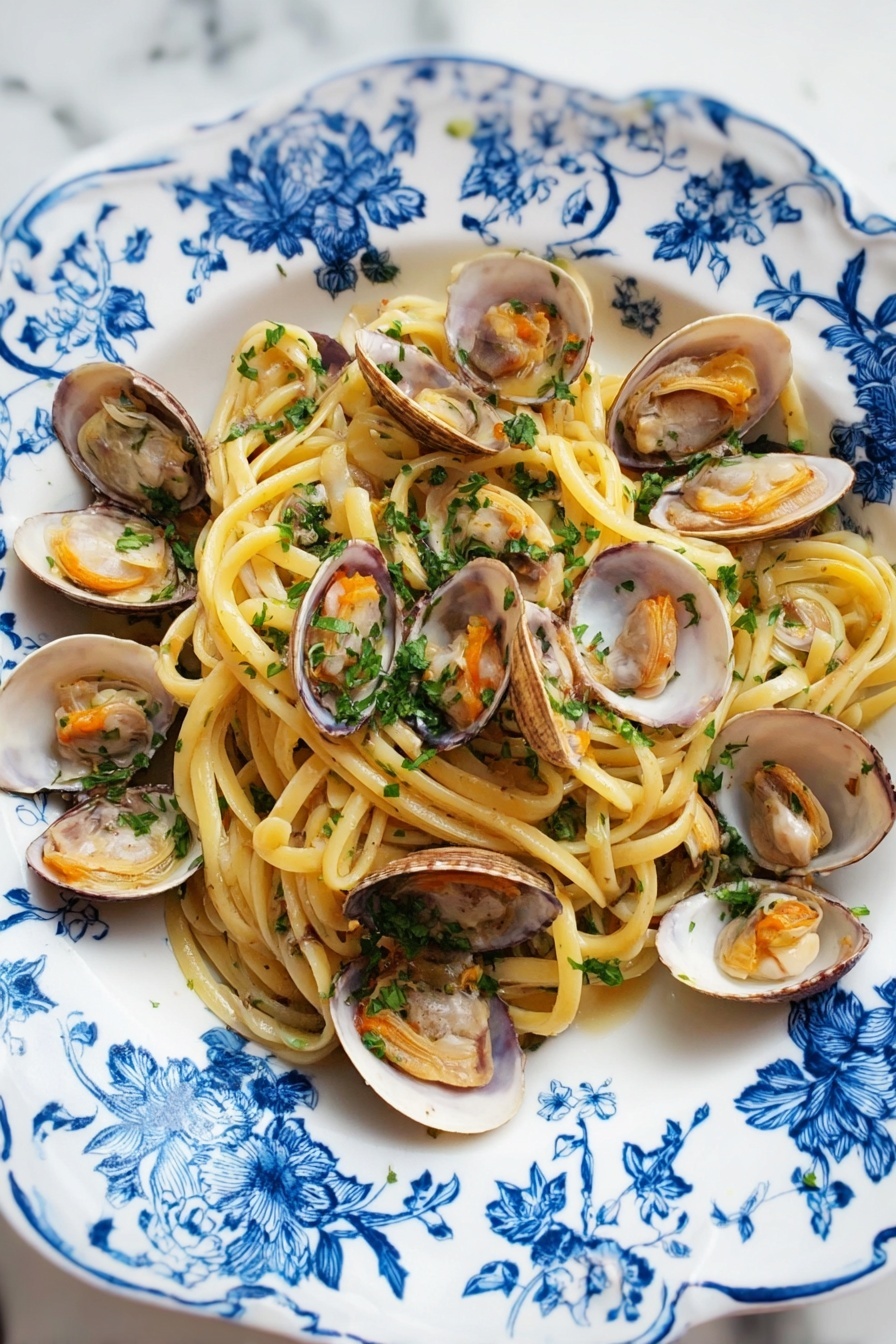
Garnishes
I always finish with a generous sprinkle of fresh parsley right before serving—it adds such a lovely brightness. Sometimes, I’ll add a few twists of freshly cracked black pepper or a drizzle of high-quality extra virgin olive oil on top for added richness. Lemon wedges on the side are optional but I think they’re a nice touch if you want a little extra zing.
Side Dishes
For sides, think simple: a crisp green salad with a light vinaigrette or some crusty ciabatta to soak up that garlicky clam sauce. Roasted or grilled vegetables like asparagus or zucchini pair wonderfully and keep things light so the clams shine.
Creative Ways to Present
When I’ve made this for dinner parties, I’ve served the pasta straight from a shallow bowl with the clams elegantly arranged on top for visual impact. Another fun idea is serving individual portions in deep plates with a sprig of parsley and a lemon wedge artfully placed—it feels like a restaurant experience at home!
Make Ahead and Storage
Storing Leftovers
If you have leftovers, store them in an airtight container in the fridge. I’ve noticed that the pasta absorbs some sauce overnight, so before reheating, add a splash of water or broth to loosen things up and keep it saucy.
Freezing
Freezing cooked clams and pasta together isn’t my favorite because the texture can become rubbery. However, if you freeze the clams separately in broth, it works better. For best results, enjoy this fresh whenever possible—it really shines when freshly made.
Reheating
To reheat, I gently warm the leftovers in a skillet over low heat with a bit of olive oil or water to refresh the sauce. Microwaving works too but can overcook the clams if you’re not careful. Stir often for even heating and to keep the pasta from sticking.
FAQs
-
Can I use frozen clams for this Linguine with Clams Recipe?
While fresh clams are ideal for the best flavor and texture, you can use frozen clams if fresh aren’t available. Just make sure they’re properly thawed and drained so they don’t add excess water to your dish. Keep in mind, frozen clams may have a slightly different texture and won’t release as much natural juice for the sauce.
-
Why don’t you add salt to the pasta water?
The clams bring natural saltiness to the dish, so adding salt to the pasta water isn’t usually necessary. This helps keep the overall flavor balanced and prevents the pasta from becoming too salty before it mingles with the clam sauce.
-
What type of wine works best in this recipe?
A dry white wine like Pinot Grigio or Sauvignon Blanc is perfect. It adds acidity and depth without overpowering the delicate clam flavor. If you don’t want to use wine, you can substitute with a bit of clam broth or simply omit it.
-
How do I avoid sandy clams in my dish?
Rinse clams thoroughly under cold water and allow them to purge sand by soaking them in salted water for about 20 minutes before cooking. Also, filtering the clam cooking liquid through a fine sieve helps remove any residual grit that might affect your sauce.
Final Thoughts
This Linguine with Clams Recipe holds a special place in my heart because it brings a little piece of the Italian coast right to my dinner table. It’s a rewarding balance between simplicity and sophistication, and I love how it’s perfect for making memorable meals without fuss. I hope you’ll try making this soon—you’ll enjoy not just the flavors but the fun ritual of steaming clams and tossing pasta together. Buon appetito, my friend!
Print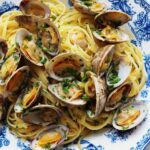
Linguine with Clams Recipe
- Prep Time: 20 minutes
- Cook Time: 25 minutes
- Total Time: 45 minutes
- Yield: 4 servings
- Category: Main Course
- Method: Stovetop
- Cuisine: Italian
Description
Linguine alle Vongole is a classic Italian pasta dish from Naples featuring fresh clams cooked with garlic, chili, parsley, and white wine, tossed with linguine for a simple yet flavorful seafood meal perfect for any special occasion.
Ingredients
Pasta
- 11 ounces linguine (or vermicelli or spaghetti)
Clams and Seafood Sauce
- 1.8 pounds fresh clams (about 200g/7oz per person)
- 5-8 garlic cloves (peeled and finely chopped)
- 1 teaspoon peperoncino (red chili pepper) or dried flakes (adjust to taste)
- 4-5 tbsp extra virgin olive oil
- 1-2 handfuls fresh parsley (finely chopped)
- salt (to taste, not added to pasta cooking water)
- 2.5 fl oz dry white wine (optional)
Instructions
- Prepare Ingredients: Finely chop the peeled garlic and parsley. If using fresh or dried red chili, chop finely and remove seeds for mild heat. Wash hands carefully afterward to avoid irritation.
- Clean Clams: Rinse clams under cold water, discarding any with broken shells. Rinse thoroughly to remove sand; some sandiness can be filtered out later.
- Boil Pasta Water: Bring a pot of water to boil for the pasta. Do not add salt as clams add natural saltiness.
- Cook Clams: Place clams in a deep frying pan, cover, and cook over medium-high heat until clams open, about 5 minutes.
- Prepare Clams and Broth: Let clams cool slightly. Remove meat from half the shells, keeping the rest intact. Discard empty shells and filter clam cooking liquid to remove sand but keep it for sauce.
- Cook Pasta: Add pasta to boiling water and cook al dente following package instructions.
- Make Sauce: Heat half the olive oil in a frying pan or skillet. Add garlic and peperoncino, sauté until garlic softens. Add clams (both shelled and unshelled) and cook briefly. Pour in filtered clam liquid followed by white wine if using; cook until alcohol evaporates. Continue cooking for 3-5 minutes, then remove from heat.
- Combine Pasta and Sauce: Drain pasta and add it to the pan with the clams and sauce. Toss gently over low heat to combine.
- Finish and Serve: Stir in chopped parsley and a drizzle of olive oil. Serve immediately with extra parsley on top if desired.
Notes
- This traditional Neapolitan dish uses minimal ingredients but delivers maximum flavor.
- It’s ideal for special occasions or entertaining guests with its impressive yet simple seafood profile.
- Do not salt the pasta water as clams impart sufficient saltiness.
- Filtering clam broth is important to remove any residual sand.
- Adjust peperoncino quantity according to preferred spice level.
Nutrition
- Serving Size: 1 serving
- Calories: 447 kcal
- Sugar: 2 g
- Sodium: 31 mg
- Fat: 16 g
- Saturated Fat: 2 g
- Unsaturated Fat: 12 g
- Trans Fat: 0.01 g
- Carbohydrates: 61 g
- Fiber: 3 g
- Protein: 15 g
- Cholesterol: 9 mg






